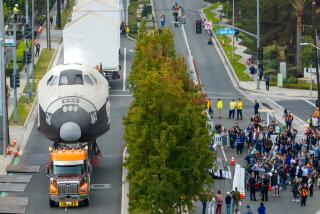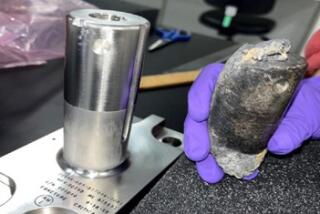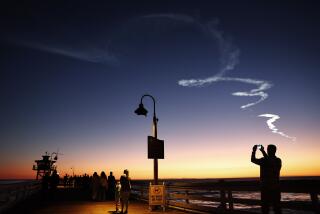Space junk drifting toward astronauts
- Share via
CAPE CANAVERAL, FLA. — A massive piece of space junk drifted toward the International Space Station and its 13 astronauts Wednesday, although NASA officials said the threat would not delay tonight’s spacewalk.
Mission Control kept close tabs on the piece of debris because there was a chance, however unlikely, that it could come too close or even hit the linked shuttle Discovery and space station if their path is not altered.
As of Wednesday night, the junk was expected to pass within two miles of the outpost Friday, said John McCullough, chief of NASA’s flight director office.
That’s five miles closer than earlier projections, but it’s “looking very positive” that the shuttle and station will not have to move into a higher orbit to avoid it. With every passing hour, NASA’s ability to judge the precise location of the spacecraft and debris becomes more accurate, McCullough said.
Experts will continue to track the debris -- part of a 3-year-old European Ariane 5 rocket -- to make sure it stays at a safe distance.
Pieces of space junk sometimes stray from their orbit, however, and the object’s oval-shaped orbit -- stretching as far out as 20,000 miles -- makes it difficult to monitor.
The late-breaking news did not affect the work of the two crews aboard the space complex.
They moved more cargo into the space station and installed some of the new big-ticket items, including a sleeping compartment.
Shuttle astronaut Jose Hernandez, a Mexican American who was born in French Camp, Calif., and grew up in a migrant worker family, also took time out for several television interviews and discussed his Roman Catholicism.
When asked in Spanish whether being surrounded by all that space technology diminished his faith, Hernandez replied that on the contrary, seeing all the stars confirmed his belief that all this cannot possibly be by chance and that there is a greater plan with a supernatural power.
“You can see with your eyes how marvelous our world is, our atmosphere is,” he said.
If Mission Control determines that the shuttle-station complex needs to dodge the debris, it would not move into a higher orbit until early Friday, just after the spacewalk. The joined spacecraft are about 220 miles above Earth.
More to Read
Sign up for Essential California
The most important California stories and recommendations in your inbox every morning.
You may occasionally receive promotional content from the Los Angeles Times.










